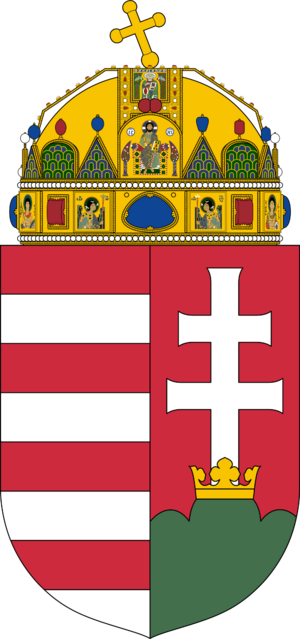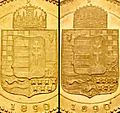Coat of Arms of Hungary facts for kids
The coat of arms of Hungary is a very old and important symbol for the country. It was officially chosen on July 3, 1990. This happened after Hungary stopped being a communist country. But many parts of this coat of arms are much older. Some parts even go back to the Middle Ages. This symbol shows Hungary's history and its land.
Contents
What the Hungarian Coat of Arms Looks Like
The coat of arms has several key parts. Each part tells a story about Hungary.
The Stripes and Rivers
One part of the coat of arms has four red and four white stripes. These stripes are very traditional. The white stripes are often called "silver" in heraldry. They stand for four important rivers in Hungary. These rivers are the Duna (Danube), Tisza, Dráva, and Száva.
The Double Cross and Crown
On the right side of the shield, there is a white double cross. This cross sits on a red background. Above the cross, there is a small golden crown. This crown is placed on top of three green hills.
The Green Hills and Mountains
The three green hills below the crown are also very symbolic. They represent three mountain ranges in Hungary. These mountains are the Tatra, Mátra, and Fátra. The Fátra mountains include the Veľká Fatra and Malá Fatra ranges.
History of the Coat of Arms
The design of the Hungarian coat of arms has changed over time. Sometimes, it was used with the Holy Crown of Hungary. Other times, it was part of a bigger, more detailed coat of arms. But the main parts, like the stripes, cross, and hills, have been important for centuries. After the communist rule ended, Hungary chose this traditional design again. It shows the country's long history and national pride.
Related pages
Images for kids
-
Arms of Hungary on an 1890 Austro-Hungarian forint coin. The version on the right includes the arms of Fiume.
See also
 In Spanish: Escudo de Hungría para niños
In Spanish: Escudo de Hungría para niños




